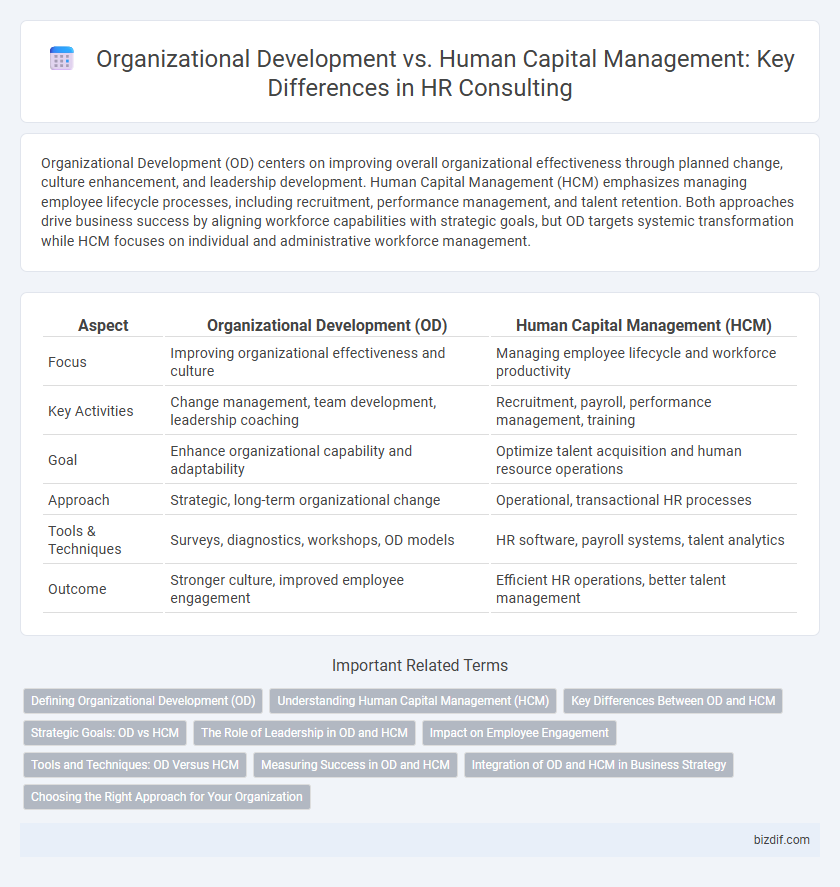Organizational Development (OD) centers on improving overall organizational effectiveness through planned change, culture enhancement, and leadership development. Human Capital Management (HCM) emphasizes managing employee lifecycle processes, including recruitment, performance management, and talent retention. Both approaches drive business success by aligning workforce capabilities with strategic goals, but OD targets systemic transformation while HCM focuses on individual and administrative workforce management.
Table of Comparison
| Aspect | Organizational Development (OD) | Human Capital Management (HCM) |
|---|---|---|
| Focus | Improving organizational effectiveness and culture | Managing employee lifecycle and workforce productivity |
| Key Activities | Change management, team development, leadership coaching | Recruitment, payroll, performance management, training |
| Goal | Enhance organizational capability and adaptability | Optimize talent acquisition and human resource operations |
| Approach | Strategic, long-term organizational change | Operational, transactional HR processes |
| Tools & Techniques | Surveys, diagnostics, workshops, OD models | HR software, payroll systems, talent analytics |
| Outcome | Stronger culture, improved employee engagement | Efficient HR operations, better talent management |
Defining Organizational Development (OD)
Organizational Development (OD) is a strategic approach focused on improving an organization's effectiveness through planned interventions in its processes, culture, and structure. OD emphasizes change management, leadership development, and enhancing team dynamics to foster continuous improvement and adaptability. This differs from Human Capital Management (HCM), which primarily deals with workforce administration, talent acquisition, and employee lifecycle management.
Understanding Human Capital Management (HCM)
Human Capital Management (HCM) focuses on strategically acquiring, managing, and optimizing an organization's workforce to enhance productivity and achieve business goals. It encompasses talent acquisition, employee engagement, performance management, and learning and development initiatives. Unlike Organizational Development (OD), which centers on improving organizational processes and culture, HCM prioritizes maximizing individual employee value through data-driven HR practices.
Key Differences Between OD and HCM
Organizational Development (OD) emphasizes planned change initiatives to improve company culture, employee engagement, and overall organizational effectiveness, focusing on long-term transformational strategies. Human Capital Management (HCM) centers on managing employee lifecycle processes such as recruitment, payroll, performance management, and compliance to maximize workforce productivity. While OD drives systemic change and learning interventions, HCM ensures operational efficiency and talent administration within the HR function.
Strategic Goals: OD vs HCM
Organizational Development (OD) prioritizes aligning culture, structure, and processes to drive long-term strategic transformation and sustain competitive advantage. Human Capital Management (HCM) focuses on optimizing the workforce through talent acquisition, performance management, and employee engagement to meet immediate business objectives. Both OD and HCM contribute to strategic goals but address different dimensions: OD targets systemic change, while HCM emphasizes human resource efficiency and capability.
The Role of Leadership in OD and HCM
Leadership drives Organizational Development (OD) by fostering a culture of continuous improvement and aligning change initiatives with strategic goals. In Human Capital Management (HCM), leadership plays a critical role in talent acquisition, employee engagement, and performance optimization to enhance workforce productivity. Effective leaders integrate OD and HCM strategies to build agile organizations capable of adapting to evolving business environments.
Impact on Employee Engagement
Organizational Development (OD) enhances employee engagement by fostering a culture of continuous improvement and aligning organizational values with employee goals. Human Capital Management (HCM) drives engagement through strategic talent acquisition, performance management, and personalized employee development programs. Both OD and HCM contribute to higher employee satisfaction and retention by addressing different facets of workforce motivation and productivity.
Tools and Techniques: OD Versus HCM
Organizational Development (OD) leverages tools like change management models, team-building exercises, and culture assessments to enhance organizational effectiveness and employee engagement. Human Capital Management (HCM) utilizes techniques such as talent acquisition software, performance management systems, and workforce analytics to optimize employee lifecycle and data-driven decision-making. Both OD and HCM employ diagnostics and feedback mechanisms, but OD focuses on systemic change, while HCM emphasizes transactional HR processes and technology integration.
Measuring Success in OD and HCM
Organizational Development (OD) measures success through metrics like employee engagement, cultural alignment, and change adoption rates, reflecting its focus on improving organizational effectiveness and adaptability. Human Capital Management (HCM) emphasizes quantifiable outcomes such as talent acquisition efficiency, turnover rates, and workforce productivity to evaluate the impact of HR processes on business performance. Combining OD's qualitative insights with HCM's quantitative data provides a comprehensive approach to assessing HR initiatives' overall success.
Integration of OD and HCM in Business Strategy
Integrating Organizational Development (OD) and Human Capital Management (HCM) enhances business strategy by aligning workforce capabilities with long-term organizational goals, driving sustainable growth. OD focuses on change management and culture transformation, while HCM emphasizes talent acquisition, performance, and employee engagement, making their integration critical for holistic workforce optimization. This synergy improves leadership development, succession planning, and operational efficiency, ensuring businesses adapt effectively to market dynamics.
Choosing the Right Approach for Your Organization
Organizational Development (OD) emphasizes change management, culture transformation, and long-term strategic growth through employee engagement and leadership development, making it ideal for organizations seeking holistic improvement. Human Capital Management (HCM) focuses on workforce administration, talent acquisition, performance metrics, and compliance, providing operational efficiency and data-driven insights for HR processes. Choosing between OD and HCM depends on your organization's immediate needs: prioritize OD for adaptive, culture-centric growth or HCM for optimizing talent management systems and workforce analytics.
Organizational Development (OD) vs Human Capital Management (HCM) Infographic

 bizdif.com
bizdif.com